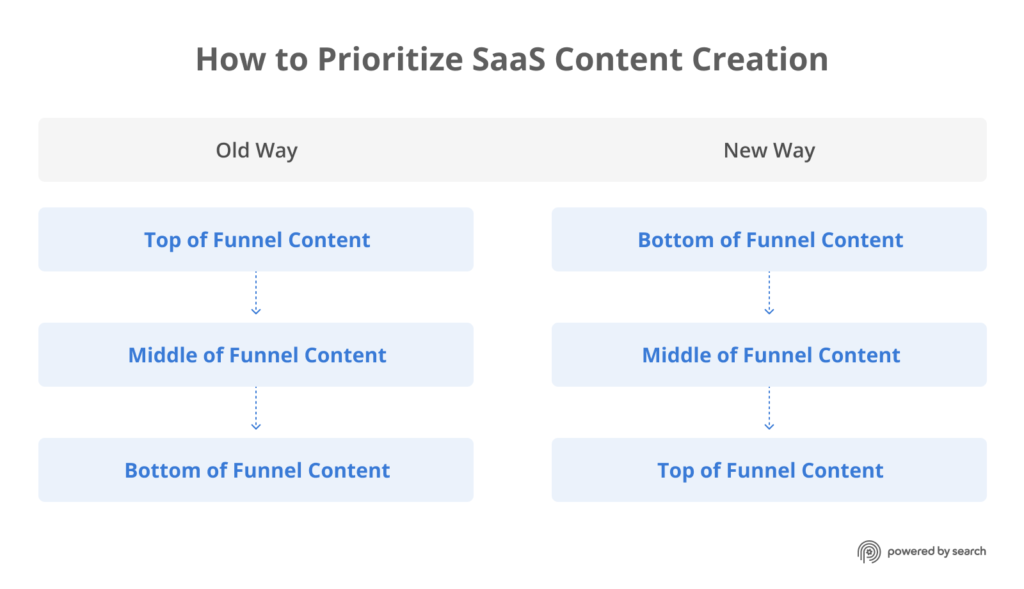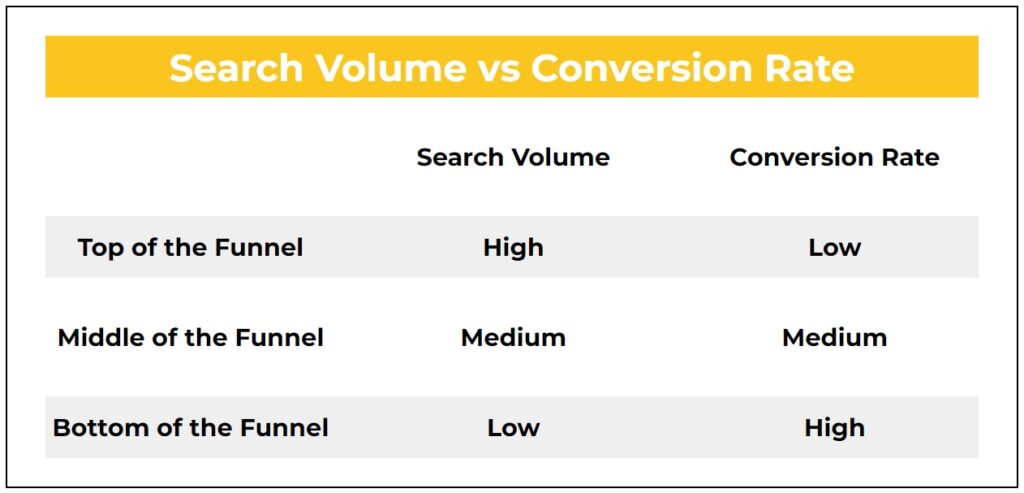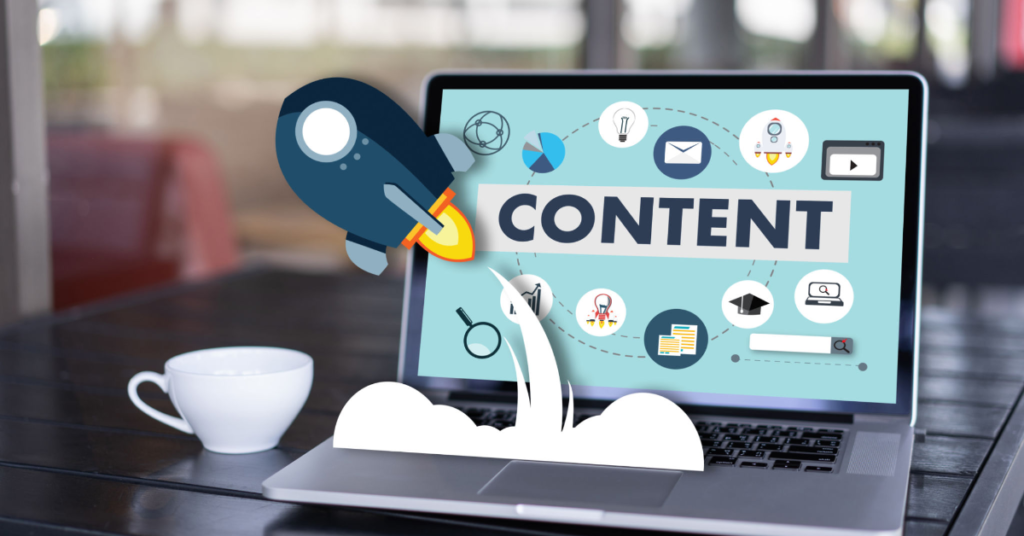In the B2B world, many companies are building up their blogs and promotional materials but don’t have a well-defined SaaS content strategy. And without a good structure, the whole thing can be a hit or miss.
To serve your readers in the best way possible, you will need to define your audience, the stage in their buying journey, and the appropriate message for each stage. This way you can tailor your content to each stage of the bowtie funnel to maximize your outcome.
Understanding user awareness
In his book, Breakthrough Advertising, Eugene Schwartz identifies 5 stages of consumer awareness. In SaaS, we can use these to categorize our blog articles and other marketing materials to make sure the content will be relevant to specific audiences.
This way, we can cover the particular informational needs of users ranging from the ones who have no idea there is a problem to those with vast experience and have already tried several tools.
- Completely Unaware: The prospect isn’t even aware of the problem your product solves, let alone your product itself.
- Problem Aware: The prospect recognizes they have a problem, but they might not understand the full scope of it or be actively seeking solutions.
- Solution Aware: The prospect knows there are solutions to their problem, but they might not be familiar with the specific type of solution your product offers.
- Product Aware: The prospect is aware of your product and similar products in the market and is considering their options.
- Most Aware: The prospect is very familiar with your product, understands its benefits, and is likely ready to buy.
Where to start
With so many channels and content formats available you can easily become overwhelmed. But the most important step you can take is to look at your business and ask yourself a few questions:
- What is the level of maturity of your business?
- Are users familiar with the product category or your brand?
- Where is your audience spending time online?
- What type of information are users looking for?
- What are your competitors doing?
These are not the only questions you can ask yourself, but it’s a good starting point.
After that, look at what resources you have and what type of content you can publish. If you can consistently produce written content, focus on building your company’s blog. Then, check whether you can complement that with video content, case studies, and testimonials. Video testimonials work best. But if you can’t do them, written testimonials will do for now.
The main idea is that there are a lot of opportunities out there. You will just need to sift through them and select the ones that make sense for your business.
SaaS content strategy building blocks
When breaking down the content strategy into smaller pieces. This way you can be more intentional about what type of content you deliver and to whom.
Top of the funnel
The goal of the top of the funnel content is to attract new visitors and make them aware of the problem you are trying to solve. These are the completely unaware users. So, your focus is to educate them about the problem and get them into the problem aware group.
You can do this with:
- Expert roundups and expanded list posts
- Opinion and market trend pieces
- Ultimate guides
Middle of the funnel
The people in the middle of the funnel are already problem aware or even solution aware. They already know something about the topic, so they will need some more ‘meaty’ content.
You can do this with:
- ‘How to’ articles
- ‘X tips to’ articles
- ‘Top X’ or ‘The best’ solution articles
- ‘Alternative to’ articles
Bottom of the funnel
In this stage, people are already product aware or most aware. So you would want to make the distinction between the product aware users which are mostly potential customers and the most aware which are most likely to be agencies or consultants.
It is important to create different types of content because of the level of knowledge and the way they would use your product. For the most aware you want to create content that attracts them to become partners. You want them to recommend your solution to their clients.
You can do this with:
- Versus articles
- Product detail articles or landing pages
- Partner success stories
- Use cases pages
Putting it all together
The typical logic that comes to mind when creating content is to follow the funnel. You start with the higher funnel content and move down to the bottom of the funnel content.
Even though this might seem like a good way of guiding your users, it may take months or years to yield results. This is due to focusing on demand generation vs. focusing on demand capture.
In the beginning, you need to get customers as fast as possible. So you must focus on the people who are already in the market for a solution like yours. And these users will not miss the high-level information – they already know it!

This approach will get you less traffic, but it is more likely to convert. This is because there is a tradeoff between volume and conversion rate between the different funnel stages.

SaaS content strategy example
Let’s assume you have an app called ‘Serendipity’. The app helps ecommerce businesses show related products on every product page and increase the average order value. Based on what we’ve discussed earlier, let’s create the SaaS content strategy for it.
We assume that the company is already on the market for a while. If your company is young don’t even bother with content marketing yet. Focus on getting your first 10-15 customers, use their feedback to improve your product, and get referrals. After that, create a few case studies, and get your PPC campaigns and content marketing up and running.
Step 1: Bottom of the funnel
Audience: Product aware
Type of content: blog articles, landing pages, case studies
If you have done a good job getting your first clients and first referrals, you will also get some traffic on your brand name. Most likely this will be through word of mouth. And when those visitors search for your product, you want to tell them exactly what you can do for them because they are a few keystrokes away from signing up.
These users will most likely want to know how your software compares to other tools and what are the advantages of choosing you.
Content pieces examples:
Case studies
- How Serendipity helped [client] increase their average order value by 48%
- How [client] increased their profitability with upsells
Landing pages
- Serendipity versus [competitor]
- Integrating Serendipity with Shopify
Blog articles
- Serendipity: The Secret Weapon for E-commerce Upselling and Cross-Selling
- Is Serendipity Right for Your Business? Here’s How it Works
- Revolutionize Your Upselling: See How Serendipity Increases Average Order Value
- Boost Sales and Customer Satisfaction with Data-Driven Product Recommendations
- Case Studies: How E-commerce Businesses Like Yours Use Serendipity for Success
Step 2: Middle of the funnel
Audience 1: Solution aware
Type of content: blog articles
To target these users you will focus on presenting the product, but not describe it in detail as you would for product aware users. Because they already know there is software out there to help them with their problem, you can present them with the solution they are looking for and mention your app as the product they need.
Content pieces examples:
Blog articles
- The Magic of Related Products: How to Increase Sales Without Lifting a Finger
- Data-Driven Upselling: Unveiling the Secrets of High-Converting Recommendations
- AI for E-commerce: How Smart Technology Can Boost Your Bottom Line
- From “Meh” to Marvelous: How Personalized Product Recommendations Enhance Customer Experience
- Forget Guesswork: The Science Behind Effective Upselling Strategies
Audience 2: Problem aware
Type of content: blog articles
At this stage, users know they have a problem, but they do not know how to solve it. So you will have to help them discover what is the source of the problem and present your software as the solution for it.
Blog articles
- Struggling with Low Average Order Value? You’re Not Alone (Here’s Why)
- The Art and Science of Customer Engagement: Why They Don’t Buy More
- Cart Abandonment Blues? It’s Time to Rethink Your Upselling Strategy
- Boosting Customer Lifetime Value: Simple Strategies for E-commerce Growth
- Turning Window Shoppers into Loyal Buyers: The Power of Personalization
Step 3: Top of the funnel
Audience: Completely unaware
Type of content: blog articles
At this stage, people are oblivious that they even have a problem. So your content strategy should focus on the type of content they are looking for, but it is not directly related to your software. This would be content that is relevant to the broader ecommerce audience in which you can also briefly mention the problem your tool is solving.
Content pieces examples:
Blog articles
- These Shocking Stats Reveal You’re Leaving Money on the Table
- 5 Signs Your Customers Might Be Leaving Happy, But Not Satisfied
- The Hidden Cost of Missed Upselling Opportunities
- Is Your E-commerce Store Stuck in Autopilot? Here’s Why You Should Care.
- Beyond Discounts: How to Delight Your Customers and Boost Revenue
Step 4: Bottom of the funnel
Audience: Most aware
Type of content: blog articles, landing pages, case studies
For the most aware users, even though it’s step 4 in this list, you shouldn’t wait until the rest of the content is done. You should do it whenever it makes sense. Did you get enough traction with your other pieces of content and paid search traffic? Do you have a constant stream of leads and clients coming in every month? Then, you should have the data to back up your claims and convince the most aware users to choose your tool.
But this type of user is also the hardest one to convince. Because we are talking about agencies and consultants. They have already worked with a bunch of apps like yours.
However, if you manage to get them on board as partners, they will do the selling for you. This decreases your cost of acquisition and will help your business grow faster.
Content pieces examples:
Case studies
- How [partner] helped [their client] to increase their revenue by 33% with Serendipity
- How [partner] increased customer retention by delivering better results using Serendipity
Landing pages
- Partner program
- Partner success stories
Blog articles
- The Holy Grail: How to Increase Ecommerce Client AOV Without Breaking the Bank
- From Frustration to Fortune: 3 Case Studies of Agencies Using Serendipity to Supercharge Client Sales
- The Psychology of Upselling and Cross-Selling: How Serendipity Makes it Effortless
- Data-Driven Decisions for Peak Performance: How Serendipity Provides Actionable Insights for Your Ecommerce Clients
- The Future of Ecommerce Personalization: How Serendipity Stays Ahead of the Curve



